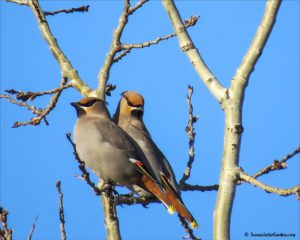Waxwings
 1. Bohemian (Bombycilla garrulus) _ Length 8.25″, wingspan 14.5″ (1st and 3rd photos)
1. Bohemian (Bombycilla garrulus) _ Length 8.25″, wingspan 14.5″ (1st and 3rd photos)
2. Cedar (Bombycilla cedrorum) _ Length 7.25″, wingspan 12″ (2nd photo)
What they eat: Berries, crabapples and other fruits, and insects
Habitat: Forests, woodlands
Plants that attract: Trees and shrubs bearing fruit (American Cranberry Bush, crabapples)
Where they nest: In trees, their nests tend to be a messy tangle
 My observations: This is another of my favorite birds! I mean, how could you not love their little bandit masks and watching their antics while scarfing down berries and crabapples? In the past, we’ve primarily seen them during the fall and winter months. This year, we were delighted to have a pair choose the hawthorn in our backyard for nesting. Unfortunately, a House Wren put an end to that (sigh) but at least we now know they aren’t just cold weather visitors. And who knows? Maybe they’ll be more successful next year.
My observations: This is another of my favorite birds! I mean, how could you not love their little bandit masks and watching their antics while scarfing down berries and crabapples? In the past, we’ve primarily seen them during the fall and winter months. This year, we were delighted to have a pair choose the hawthorn in our backyard for nesting. Unfortunately, a House Wren put an end to that (sigh) but at least we now know they aren’t just cold weather visitors. And who knows? Maybe they’ll be more successful next year.
 I find it tricky to differentiate the Bohemians from the Cedar Waxwings although, as you can see by the above statistics, the latter a slightly smaller. Both adult birds have brown bodies, yellow-tipped tails and some red visible when their wings are folded. But the big difference is that Bohemians have brownish-red coverts under their tail feathers while the Cedar Waxwings have white coverts. So that’s where you need to look while puzzling over which type of bird you have! Of course, immature birds will be less distinctively marked, so just do the best you can and enjoy the fact that they’ve come for a visit. They typically group together in large flocks during the winter months and are easily flushed when startled.
I find it tricky to differentiate the Bohemians from the Cedar Waxwings although, as you can see by the above statistics, the latter a slightly smaller. Both adult birds have brown bodies, yellow-tipped tails and some red visible when their wings are folded. But the big difference is that Bohemians have brownish-red coverts under their tail feathers while the Cedar Waxwings have white coverts. So that’s where you need to look while puzzling over which type of bird you have! Of course, immature birds will be less distinctively marked, so just do the best you can and enjoy the fact that they’ve come for a visit. They typically group together in large flocks during the winter months and are easily flushed when startled.
Back to My Backyard Birds
